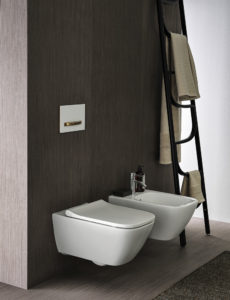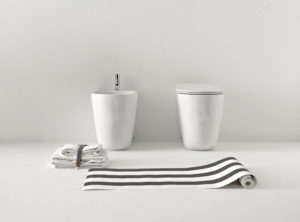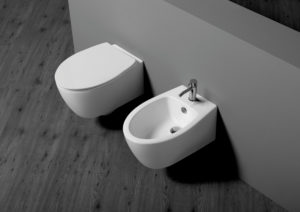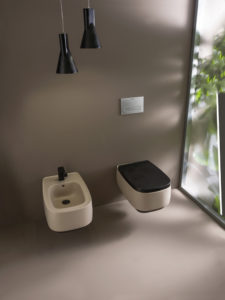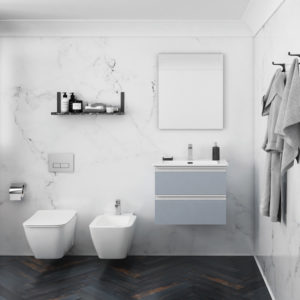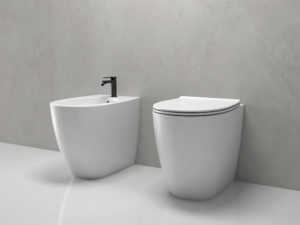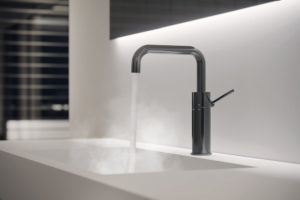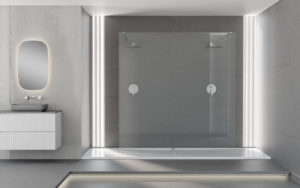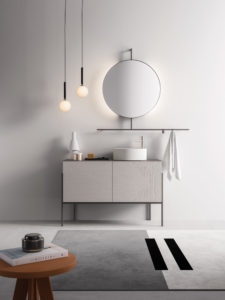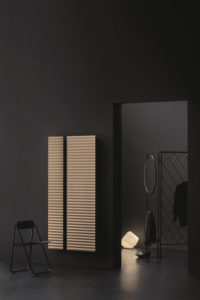Products Trends


The goal? Water savings! | by Antonia Solari
A useful starting point for any discussion of sustainability in the bathroom, especially one that concerns water consumption, is to take a look at the figures. We each consume on average 200 litres of water per day, including 75 to 80 litres of water for a 5-minute shower – corresponding to an average consumption of 12 to 16 litres per minute in the case of older shower systems. However, new generation taps are capable of reducing water consumption to 9 litres per minute, resulting in considerable savings. Similarly, modern low-flush toilets reduce water usage to less than 6 litres per flush compared to the 6-12 litres of older WC models.
These figures demonstrate that it is possible to reduce levels of consumption and make an active contribution to water savings in the bathroom, one of the areas of the home where action on sustainability is most urgent.
To incentivise water savings, the Italian government is introducing a new tax concession with its 2021 Budget Law. The implementation decree has not yet been passed, but when approved the new legislation will offer a €1,000 bonus to individuals resident in Italy who replace ceramic WCs with new low-flush appliances and old taps with new low-flow models. With specific reference to sanitaryware, the so-called Water Bonus applies to the “supply and installation of ceramic WCs with a maximum flush volume of 6 litres or less and the associated waste systems, including plumbing and building work and the dismantling and removal of existing systems”.
The Water Bonus will be available until 31 December 2021 and has been welcomed by industry players who, as Confindustria Ceramica’s vice chairman Augusto Ciarrocchi points out, are already highly attentive to the issue of sustainability: “In keeping with their focus on technological innovation, Italian ceramic companies have already launched a number of products that comply with these limits. Passing the implementation decree for the Water Bonus would speed up the replacement of old WCs and give Italian families an additional opportunity to save water and preserve this essential resource.”
Efforts to improve sustainability in the bathroom have been extended to include water-saving solutions; low-impact and certified production processes; the use of recycled and recyclable materials such as glass and aluminium; and the application of finishes that are not only based on research into eco-friendly materials and processes but are also capable of extending the product’s lifetime as part of a philosophy of sustainability. In the majority of cases, high quality materials and processes equate with a longer lifetime, which in turn means less consumption of resources, materials and energy.
- 01.
- 02.
01. The Smyle line of sanitary fixtures from Geberit includes wall-hung and free-standing WCs with concealed wall fixing and Rimfree technology. The flush system uses 4.5 litres of water in accordance with standard EN 997, so it meets the criteria of the Water Bonus incentive. www.geberit.it
02. Thanks to its rimless system, the NoLita toilet from Kerasan reduces water usage to just 4.5/3 litres per flush. It is available in free-standing and wall-hung versions, in glossy or matt white ceramic and in 7 satin shades: moss green, brown, hazelnut, grey, iron, burgundy and black. www.kerasan.it
- 03.
- 04.
03. The LFT Spazio collection from Simas includes back-to-wall toilets with a rimless system and 4.5 litre flush in both wall-hung and freestanding versions. The series also features the Renovate System consisting of an intelligent offset waste outlet for ease of installation in renovation projects. www.simas.it
04. The Flag sanitaryware collection from Ceramica Flaminia stands out for its distinctive colour contrasts. The photo shows the version with Stripes finish in the colours Fango/Carbone. These class 1 sanitary fixtures have a maximum flush volume of 6 litres. www.ceramicaflaminia.it
- 05.
- 06.
05. The Strada II series of sanitaryware from Ideal Standard features AquaBlade technology on all WCs to ensure more effective cleaning. They have hidden fixings that do not affect the shapes of the sanitaryware units along with a softer design created by Studio Levien. The WCs consume 3-4.5 litres of water per flush. www.idealstandard.it
06. The 4ALL range of WCs from Ceramica Globo is designed to facilitate the replacement of old-generation models without the need for building work. It is installed back to wall and also meets the criteria for the Water Bonus incentives as the flush volume is less than 4 litres of water. www.ceramicaglobo.com
- 07.
- 08.
07. Velis from Nobili is a single-lever mixer tap that opens directly to cold water, reducing unintentional water heater activation and helping to reduce energy consumption. The recessed aerator also reduces the water flow, guaranteeing a flow rate of 5 litres per minute. www.grupponobili.it
08. Nook, from Fiora, is a solid surface shower tray that stands out for its asymmetric design. Thanks to its constituent material, it is resistant, non-porous and easy to clean. It comes in 120×80 cm and 200×100 cm sizes. www.fiorabath.com
- 09.
- 10.
09. Ardeco’s Industrial Collection features an eco-mortar coating, a durable and environmentally friendly material consisting of 40% recycled aggregate that is applied by hand and makes for tougher and more durable surfaces. The cabinet and vanity top are made of metal and are available in 11 colours. www.ardeco-it.com
10. Arblu is presenting its Livingstone marble powder radiant panels, an ideal solution for eco-friendly bathroom heating. The marble powder is a by-product of the marble cutting process and is bonded to the basic components of the panel in a low-temperature process that uses less energy and emits less CO2 into the environment. The catalogue includes 11 models available in 7 sizes. www.arblu.it
May 2021
Also see A new unified water label




